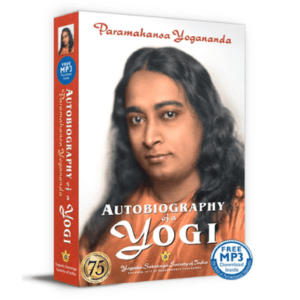Table of Contents
ToggleA Look Inside “Autobiography of a Yogi” by Paramahansa Yogananda: Unveiling the Mysteries

Paramahansa Yogananda’s “Autobiography of a Yogi” is a spiritual classic that has captivated readers for over seven decades. This book transcends the boundaries of a simple autobiography, offering a glimpse into the vibrant world of Indian mysticism, practical yoga techniques, and profound spiritual truths.
Embarking on a Journey
Divided into 49 chapters, the book weaves a tapestry of Yogananda’s life, his encounters with enlightened masters, and his experiences with the profound realities beyond the physical world. Here’s a glimpse into some key chapters:
- Early Life and Awakening (Chapters 1-7): We meet Yogananda (born Mukunda Lal Ghosh) as a curious child yearning for a deeper spiritual connection. His encounters with saints and his mystical experiences plant the seeds of his lifelong pursuit of God-realization.
- Finding His Guru (Chapters 8-12): Driven by an insatiable thirst for knowledge, Yogananda relentlessly searches for a true guru. His quest leads him to Swami Sri Yukteswar Giri, a revered yogi who becomes his spiritual guide and mentor.
- Yogic Training and Miracles (Chapters 13-21): Under Yukteswar’s tutelage, Yogananda delves deep into yogic practices, meditation techniques, and ancient scriptures. He experiences extraordinary phenomena like samadhi (enlightened consciousness) and materializes objects at will.
- Divine Encounters (Chapters 22-28): Yogananda recounts his meetings with other saints and masters, each offering unique insights and perspectives on the spiritual path.
- America Bound (Chapters 29-32): In 1920, Yogananda embarks on a life-changing journey to the United States. He is entrusted by his guru to spread the teachings of Kriya Yoga, a powerful meditation technique, to the West.
- Spreading the Light (Chapters 33-42): Yogananda establishes the Self-Realization Fellowship, teaching yoga and meditation to thousands across America. He bridges the gap between East and West, presenting Eastern wisdom in a way relatable to Western audiences.
- Life Beyond the Body (Chapters 43-48): Drawing on his own experiences and yogic scriptures, Yogananda sheds light on the mysteries of death, the afterlife, and reincarnation.
- The Farewell Call (Chapter 49): The book concludes with Yogananda’s passing in 1952, leaving behind a legacy of spiritual wisdom and inspiration.
Key Learnings: A Compass on Your Spiritual Journey
As you delve deeper into “Autobiography of a Yogi,” several key takeaways emerge:
- The Universality of Truth: Yogananda emphasizes the underlying unity of all religions. He demonstrates how diverse spiritual paths converge towards the same divine essence.
- The Power of Yoga: The book unveils the transformative potential of yoga. Yogananda explains how yogic practices can enhance physical, mental, and spiritual well-being.
- The Importance of Meditation: Kriya Yoga, a central theme, is presented as a powerful tool for inner exploration and God-realization.
- The Reality Beyond: Yogananda offers insights into the subtle realms of existence, breaking down the barriers between the physical and spiritual worlds.
- Living a Purposeful Life: The book inspires readers to live a life guided by higher ideals, seeking truth, serving humanity, and ultimately attaining self-realization.
A Timeless Treasure: Why You Should Read It
“Autobiography of a Yogi” is more than just a captivating read. It’s a life-changing experience that can open your mind to new possibilities. Whether you’re a seasoned spiritual seeker or simply curious about the unknown, this book offers valuable insights and practical tools for your journey.
Here are some compelling reasons to add this book to your reading list:
- A Gateway to Eastern Wisdom: Yogananda presents complex spiritual concepts in a clear and engaging way, making them accessible to a wide audience.
- A Source of Inspiration: The book is filled with stories of resilience, faith, and the unwavering pursuit of truth. It leaves you feeling empowered to embark on your own spiritual exploration.
- Practical Techniques: Yogananda doesn’t just talk about spirituality; he offers practical meditation techniques like Kriya Yoga that readers can incorporate into their daily lives.
- A Bridge Between Cultures: The book fosters understanding and appreciation for Eastern philosophies and practices, creating a bridge between Eastern and Western thought.
Kriya Yoga – Profound method of Meditation
In the “Autobiography of a Yogi”, Paramhansa Yogananda introduces Kriya Yoga, a profound method of meditation. Here are the key points about Kriya Yoga from the book:
- Scientific Approach: Kriya Yoga is a systematicapproach to spiritual development. It emphasizes firsthand human experience and self-awareness. Yogananda describes it as a scientific method, which means it is based on principles that can be understood and practiced.
- Oneness with the Divine: The ultimate goal of Kriya Yoga is to achieve oneness with the Divine. Through this practice, one can experience a deep connection with the universal consciousness.
- Pranayama and Devotion: Kriya Yoga involves scientific pranayama(breath control) combined with deep devotion. Yogananda emphasizes that this combination is like mathematics—it cannot fail. By mastering the breath and cultivating devotion, practitioners can access higher states of consciousness.
- Miraculous States: Yogananda shares stories of miraculous eventswitnessed by yogis practicing Kriya Yoga. These include levitation, suspended animation (where the heartbeat and breath cease), and other extraordinary phenomena. He explains that these are not beyond explanation; they operate according to higher laws accessible to those who attain a sufficient level of realization.
- Unity with the Divine: Yogananda’s guru, Swami Sri Yukteswar, achieved identity with the Ruler of time and space. He demonstrated that there are no insurmountable barriers to merging the human with the Divine. Yogananda encourages us to recognize our own potential for spiritual transcendence.
Kriya Yoga is a powerful practice that combines breath control, devotion, and scientific principles to lead practitioners toward self-realization and inner peace. It is a path that anyone can follow, provided they approach it with sincerity and dedication.
Beyond the Summary: Exploring Themes and Profoundity
While the chapter breakdown provides a roadmap, the true essence of “Autobiography of a Yogi” lies in the profound themes and ideas it explores. Here are some key areas that will leave a lasting impression:
- Science and Spirituality: Yogananda attempts to reconcile science and religion. He presents yogic practices as a scientific exploration of the inner world, aligning with the human body’s energy systems.
- The Power of Will: The book emphasizes the importance of willpower and focused determination in achieving spiritual goals. Yogananda details practices to develop mental discipline and overcome negative habits.

- The Guru-Disciple Relationship: The profound bond between Yogananda and his guru, Sri Yukteswar, highlights the significance of a spiritual teacher in guiding and accelerating a student’s progress.
- Living a Balanced Life: Yogananda promotes a holistic approach to life, emphasizing the importance of balancing physical health, mental discipline, and spiritual growth.
- The Law of Karma: The book explores the concept of karma and its role in shaping our lives. It offers guidance for breaking negative karmic patterns and creating a more positive future.
- Vegetarianism and Ethical Living: Yogananda advocates for a vegetarian diet and a life guided by ethical principles like truthfulness, non-violence, and compassion.
A Legacy of Inspiration: Yogananda’s Enduring Influence
“Autobiography of a Yogi” has transcended the boundaries of a single book. It has become a cornerstone of Kriya Yoga practice and a source of inspiration for millions worldwide. Here’s how Yogananda’s legacy continues to resonate:
- Self-Realization Fellowship: The organization founded by Yogananda continues to share his teachings through publications, meditation centers, and educational programs. Kriya Yoga is practiced by individuals across the globe.
- Impact on Popular Culture: The book has influenced numerous celebrities, artists, and spiritual leaders, including George Harrison, Steve Jobs, and Elisabeth Kübler-Ross.
- A Call for Inner Exploration: Yogananda’s work continues to inspire a generation of seekers to delve within, explore their inner potential, and embark on a path of self-discovery.
Conclusion: A Transformational Journey Awaits
“Autobiography of a Yogi” is not just a book; it’s an invitation. It invites you to question, to explore, and to embark on your own transformational journey. Whether you’re seeking deeper meaning, improved well-being, or a connection to something greater than yourself, this book offers valuable tools and timeless wisdom.
So, pick up a copy, delve into its pages, and allow Yogananda’s words to guide you on a path towards self-realization and a life filled with purpose and peace.
Additionally, here are some resources to further explore Yogananda’s teachings:
Remember, this is just the beginning. The true magic lies in the personal journey you unlock with “Autobiography of a Yogi.”
Frequently Asked Questions
What is the main theme of “Autobiography of a Yogi”?
The main theme of “Autobiography of a Yogi” is the pursuit of spiritual enlightenment through yoga, meditation, and the guidance of a guru. Yogananda’s journey illustrates the transformative power of these practices and the profound impact of a dedicated spiritual path.
How does Yogananda describe his experiences with miracles?
Yogananda describes his experiences with miracles as natural extensions of spiritual advancement. He views miracles not as supernatural events but as demonstrations of the deeper laws of the universe that can be accessed through higher states of consciousness and spiritual practices.
What is Kriya Yoga, according to the book?
According to the book, Kriya Yoga is a highly effective spiritual technique that accelerates the practitioner’s spiritual growth. It involves specific breathing exercises and meditation practices designed to harmonize the mind and body, leading to greater spiritual awareness and direct communion with the divine.
How does “Autobiography of a Yogi” bridge Eastern and Western spirituality?
“Autobiography of a Yogi” bridges Eastern and Western spirituality by highlighting the universal principles of spiritual truth that transcend cultural and religious boundaries. Yogananda’s teachings and experiences demonstrate the commonalities in spiritual practices and philosophies, fostering a sense of unity and mutual respect among different spiritual traditions.
Why is the book considered a spiritual classic?
The book is considered a spiritual classic due to its profound impact on readers worldwide. Its inspiring stories, deep spiritual insights, and practical guidance on the path to enlightenment have made it a cherished guide for spiritual seekers. The book’s timeless wisdom and ability to resonate with people from diverse backgrounds contribute to its enduring significance in the realm of spiritual literature.

Hello There,
I’m Steve, owner of m.cheapestbookstore.com
I came across your website, and enjoyed the content. Our sites can benefit through a link exchange.
I can place a dofollow link on a relevant page. In return, I’d appreciate a dofollow link on your site.
Let’s discuss placements! Reply if interested.
Thanks,
Steve Turpin
https://m.cheapestbookstore.com